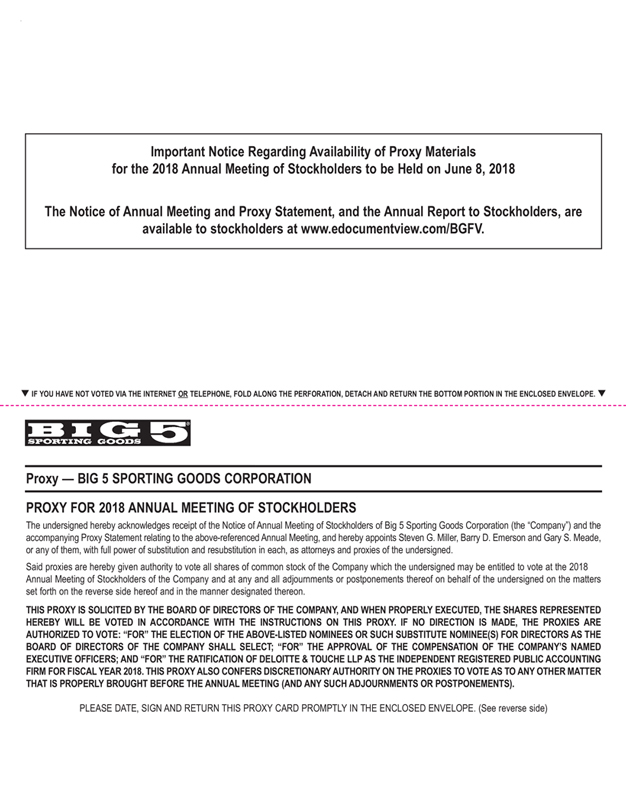PROPOSAL NO. 1
ELECTION OF DIRECTORS
(Item No. 1 on Proxy Card)
General
Proposal No. 1 concerns there-election of twothree Class CA directors. The Board consists of three classes: Class A directors, Class B directors and Class C directors. The current terms of office of the Class A directors, Class B directors and Class C directors expire in the year 2018 (Class A), the year 2019 (Class B) and the year 20172020 (Class C). The terms of the Class CA directors elected at the Annual Meeting will expire in 2020.2021. Directors are elected to three-year terms, and each director holds office until such director’s successor is duly elected and qualified.
Each of our Class CA director nominees, Jennifer H. DunbarNicholas Donatiello, Jr., Robert C. Galvin and Steven G. Miller,David R. Jessick, has consented to being named in this Proxy Statement and has agreed to serve as a Class CA director ifre-elected. Each of the nominees currently serves on the Board. Certain information with respect to these nominees, as well as our Class AB directors and Class BC directors, is set forth below. Although we anticipate that each nominee will be available to serve as a director, if any nominee becomes unable to serve or for good cause will not serve, the proxies will be voted by the proxy holders as directed by the Board.
Unless the authority to vote for one or more of our director nominees has been withheld in a stockholder’s proxy or specific instructions to vote otherwise have been given, the persons named in the proxy as proxy holders intend to vote at the Annual Meeting “for” with respect to there-election of each nominee presented below. In the election of directors, assuming a quorum is present, a nominee forre-election as a director shall bere-elected to the Board if the votes cast “for” such nominee’sre-election exceed the votes cast “against” such nominee’sre-election. All properly submitted and unrevoked proxies will be counted for purposes of determining whether a quorum is present, including those providing for abstention or withholding of authority and those submitted by brokers voting without beneficial owner instruction and exercising anon-vote. Brokernon-votes, abstentions and withheld votes will not be counted as a vote cast either “for” or “against” that nominee’sre-election and therefore will have no effect on there-election of the nominees listed below.
Based on definitions of independence established by the NASDAQ Stock Market LLC (“Nasdaq”), and the determinations of our Nominating and Corporate Governance Committee and our Board, Jennifer H. Dunbar is anNicholas Donatiello, Jr., Robert C. Galvin and David R. Jessick are and would be independent director.directors.
Required Vote
A nominee forre-election as a director shall bere-elected to the Board if the votes cast “for” such nominee’sre-election from holders of shares of stock represented and voting at the Annual Meeting exceed the votes cast “against” such nominee’sre-election.
Recommendation of the Board of Directors
THE BOARD OF DIRECTORS RECOMMENDS A VOTE “FOR”THERE-ELECTION OF THE BOARD OF DIRECTORS’ NOMINEES.
Class CA Directors Whose Terms Will Expire in 20172018 and are Nominees by the Board of Directors forRe-election at the Annual Meeting
Jennifer H. Dunbar has served as a director since February 2004. Since March 2005, Ms. Dunbar has served asCo-Founder and Managing Director of Dunbar Partners, LLC, an investment and advisory services firm. From 1994 to 1998, Ms. Dunbar was a partner with Leonard Green & Partners, L.P., a private equity firm, which she joined in 1989. Ms. Dunbar began her career as a financial analyst in the Mergers and Acquisitions Department of Morgan Stanley in 1985. Ms. Dunbar is also a member of the board of directors of PS Business Parks, Inc., a real estate investment trust, where she serves on the Audit and Compensation Committees. Ms. Dunbar has
- 5 -
served on the board of trustees of various funds in the PIMCO Funds complex since April 2015 (144 funds as ofyear-end 2016) and February 2016 (18 funds as ofyear-end 2016), respectively, where she is a member of the Audit, Governance and Valuation Oversight Committees of each board. Ms. Dunbar is the chair of the Governance Committee of the board that oversees the PIMCO equity trusts. Each of the PIMCO entities is a registered investment company under the Investment Company Act of 1940, as amended. Ms. Dunbar was formerly a member of the board of directors of 99 Cents Only Stores from 2007 to 2008. Age: 54
Ms. Dunbar has extensive financial expertise, knowledge of investment banking and experience in private equity investments and mergers and acquisitions, which we believe is valuable to our Board. We believe her past experience as a member of public company boards, including five companies in the retail sector, and as a member of a number of public company board committees, including seven audit committees, is also extremely valuable to our Board.
Steven G. Miller has served as Chairman of the Board, Chief Executive Officer and President since 2002, 2000 and 1992, respectively. Mr. Miller has also served as a director since June 2002. In addition, Mr. Miller served as Chief Operating Officer from 1992 to 2000 and as Executive Vice President, Administration from 1988 to 1992. Age: 65.
Mr. Miller has over 45 years of experience at almost every level of the Company, which we believe positions him to provide essential insight from an inside perspective of theday-to-day operations of the Company. We also believe his comprehensive knowledge of the Company’s business and the retail sporting goods industry is invaluable to our Board.
Class A Directors Whose Terms Will Expire in 2018
Nicholas Donatiello, Jr. has served as a director since June 2015. He has been the President and Chief Executive Officer of Odyssey Ventures, Inc. (“Odyssey”) since September 1993. Odyssey is a marketing and strategy consulting firm specializing in how technology changes consumer media use habits. Prior to founding Odyssey, Mr. Donatiello was President and Chief Executive Officer of Arena Systems, a technology company specializing in developing and marketing software for retail chain stores. Mr. Donatiello is a director of Dolby Laboratories, Inc., a creator of audio, imaging and communication technologies, where he chairs the Compensation Committee and sits on the Nominating and Governance and Technology Strategy Committees. He
- 5 -










